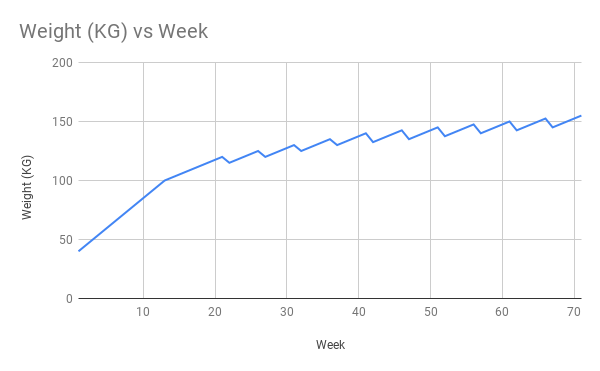Lifting Progression is critical for strength and hypertrophy. Unless you’re doing more over time your body WILL NOT have a reason to adapt and you won’t get stronger/build muscle.
You can’t do the exact same workout with the same weight, reps, sets etc forever and expect to grow indefinitely.
It doesn’t necessarily have to happen every workout (if you’re more advanced it definitely won’t) but over time your training numbers should be going on an upwards trend.

Progression will inevitably slow down as you become more advanced if all other factors are equal.
If you’re more advanced but also improve your nutrition, sleep and programming it’s possible that you would see an increase in progression speed if the compounding effect of these other factors is large enough.
This isn’t something you can do forever . At some point you’ve controlled your programming and factors outside of the gym to enough of an extent that you will see slower progress from year to year. These diminishing returns are seen in many aspects of life not just training.
There’s plenty of ways to progress. Single, double and triple progression are 3 “levels” that can be used to increase load over time.
Single involves just increasing load, double increases reps before load and triple increases sets and reps before load.
Progression Time Frame
If there was ONE strategy that can be applied to any progression scheme to adjust it as you get more advanced it would be to adjust your TIME FRAME for progression.
Novice/Beginner Progression
As a novice lifter you can just add load virtually every session/week for at least a few months, until you stall at some point. For example you could squat twice a week and increase load by 2.5kg/5lb per session, with an occasional session where the weight is maintained.
Week 1 – Squat 3*5 50kg/110lbs
Week 2 – Squat 3*5 55kg/120lbs
Week 3 – Squat 3*5 60kg/130lbs
after 12 more weeks (1 week with no weight increase)
Week 18 – Squat 3*5 115kg/255lbs
Progression is highly individual, but it wouldn’t be too unusual to begin to stall with this progression scheme at around this point if the lifter is in a caloric surplus. The lifter may then try to progress for several sessions. Even after including a couple of deload sessions they might find that they can’t add more weight and match the reps.
Early Intermediate Progression
THIS is the point where I’d increase the timeframe for progression among adjusting other thing such as training volume, intensity (% 1RM) and RPE (how close you train to failure)
The next progression scheme the lifter would use may look like this for the main squat day
Meso 1:
Week 1 Squat 1*5 107.5kg/240lbs @ RPE 6/6.5 (Deload)
Week 2 Squat 3*5 112.5kg/250lbs @ RPE 7/7.5
Week 3 Squat 3*5 115kg/255lbs @ RPE 7.5/8
Week 4 Squat 3*5 117.5kg/260lbs @ RPE 8/8.5
Week 5 Squat 3*5 120kg/265lbs @ RPE 8.5/9
An early intermediate might increase the weight by 5kg per 5 week training mesocycle instead of 5kg per week. This may seem slow compared to what you’re used to but this would be equivalent to adding over 50kg/110lbs to your working weights per year. This is probably around 60kg/135lbs a year to your squat max.
This would be insane progress for someone who has finished their novice gains. This probably wouldn’t continue for a year either so there’s no need to try to go any faster.
Meso 2:
Week 1 Squat 1*5 112.5kg/250lbs @ RPE 6/6.5 (Deload)
Week 2 Squat 3*5 117.5kg/255lbs @ RPE 7/7.5
Week 3 Squat 3*5 120kg/265lbs @ RPE 7.5/8
Week 4 Squat 3*5 122.5kg/270lbs @ RPE 8/8.5
Week 5 Squat 3*5 125kg/270lbs @ RPE 8.5/9

When Progression Slows Again
At some point the progression speed will need to slow again due to diminishing returns and the weight increases decrease to 2.5kg/5lb per meso instead. This is still 30kg per year to working sets which would be closer to 40kg to your 1RM
Progression slows after week 13, 21 and 41. In the real world progression will never look exactly like this model but it illustrates how progression may adjust as you get more advanced.

Advanced Progression when the Next Weight Jump is Too Large
When weight jumps are a larger percentage of the weight being used you may not even be able to progress this way. Jumping from the 45kg/100lb dumbells to the 47.5kg/105lb dumbells represents a roughly 5% increase in load and isn’t realistic for a more advanced lifter to do every month/training mesocycle.
In this situation there are two methods that we can use in synergy with the above strategies to see progression.
Trying to add reps and exercise variation.
If we take a low incline dumbell press (1 notch up from flat)
Meso 1:
Week 1 42.5kg/95lbs 6 @ RPE 6 Deload
Week 2 45kg/100lbs 6,6 @ RPE 6.5/7
Week 3 45kg/100lbs 7,7 @ RPE 7.5/8
Week 4 45kg/100lbs 8,8 @ RPE 8/8.5
Week 5 45kg/100lbs 9,9 @ RPE 9/9.5
Meso 2:
Week 1 42.5kg/95lbs 9 @ RPE 6 Deload
Week 2 45kg/100lbs 8,8 @ RPE 6.5/7
Week 3 45kg/100lbs 9,9 @ RPE 7/7.5
Week 4 47.5kg/105lbs 7,7 @ RPE 7.5/8
Week 5 47.5kg/105lbs 8,8 @ RPE 9/9.5
At this point you could repeat the same meso using the same structure and exercise. However there’s a possibility that you’re fairly adapted to this movement pattern and it would be better to switch to a closely related but slightly different movement. This would reduce adaptive resistance but still have carryover to the original low incline dumbell press.
A slightly higher incline dumbell press (2 notches up from flat instead of 1) would be a good substitute. You can train this movement for 2-4 mesos until you feel that it makes sense to switch back.
After switching back 2 months later you might think you haven’t gained strength or even lost a very small amount.
The newly introduced movement is still novel to your body and progression will initially be very fast as your nervous system relearns the movement pattern. By the end of the first meso back you should be noticeably stronger than the last time you did this movement.
When introducing a new variation you should compare the end of one meso to the end of another. Using the start until you’ve relearned the technique isn’t a fair comparison.
For example the first meso back may look like:
Week 1 42.5kg/95lbs 8 @ RPE 6 Deload
Week 2 45kg/100lbs 8,8 @ RPE 7/7.5
Week 3 47.5kg/105lbs 8,7 @ RPE 8
Week 4 47.5kg/105lbs 9,8 @ RPE 8/8.5
Week 5 47.5kg/105lbs 10,9 @ RPE 9/9.5
Using these two strategies in synergy with longer time frames for progression works for even very advanced lifters who have been training for a decade if they’re utilised correctly. The magnitude of improvement will just be smaller as you get more advanced.
Using Rep Ranges to Help Progression
I like to use rep ranges not just a specific rep number. In general strength mesos this may be 4-6 on strength based days and 7-9 on more hypertrophy based days. It’s a good idea to increase weight slowly from meso to meso unless you’re already at the higher end of the rep range on all sets.
This way even if you manage to progress by more than the small weight increment you can also increase reps. However if you try to increase the weight too fast the reps may drop excessively leaving you short of your desired rep range.
Bad days will happen on occasion but if you’re on top of your nutrition,sleep and stress they shouldn’t happen that often.
It’s important to keep in mind that YOU DON’T HAVE TO PUSH YOURSELF TO THE LIMIT IN EVERY SESSION TO SEE OPTIMAL PROGRESS.

I capitalise this because It took me far too long to realise this and I hope that someone reading this might really be able to internalise this. I was actually a bit paranoid that if I took an easier workout I’d regress which is kind of ridiculous.
This mentality slows down progress at some point, you might be able to get away with this as a beginner. You’re not strong enough to induce that much fatigue. It’s also not a good idea in the long term to ingrain poor movement patterns. This also increases injury risk which will slow down progression even more.
Progressive overload doesn’t necessarily have to occur from workout to workout (as the above examples show. The SRA curve just gets longer the more advanced you are. IF on average a specific week in each meso is better than the specific week in the previous meso you are progressing.
There are plenty of ways to progress. These concepts can be applied to many different types of progression and are very useful to implement when your training has seemingly hit a wall.
Interested in coaching to take your progress to the next level?